Operations Management: Manufacturing vs. Service Process Analysis
VerifiedAdded on 2020/05/11
|9
|1558
|50
Report
AI Summary
This report presents a comparative analysis of the manufacturing and service process maps of Nike and Cisco, respectively, to highlight the differences in their supply chain management. The report begins with an executive summary, followed by an introduction that sets the context for the study. It then delves into the supply chains of Nike and Cisco, detailing their respective processes through visual representations. For Nike, the manufacturing process map is broken down into product development, raw materials sourcing, assembly, and distribution. In contrast, Cisco's service process map focuses on customer relationship management, service management, and resource management. A comparison section contrasts the two companies' approaches, emphasizing the production-oriented nature of manufacturing versus the customer-support orientation of service businesses. The report concludes by summarizing the key findings and emphasizing the importance of understanding these differences for effective operations and sustainable business growth. The report utilizes academic sources to support its analysis.
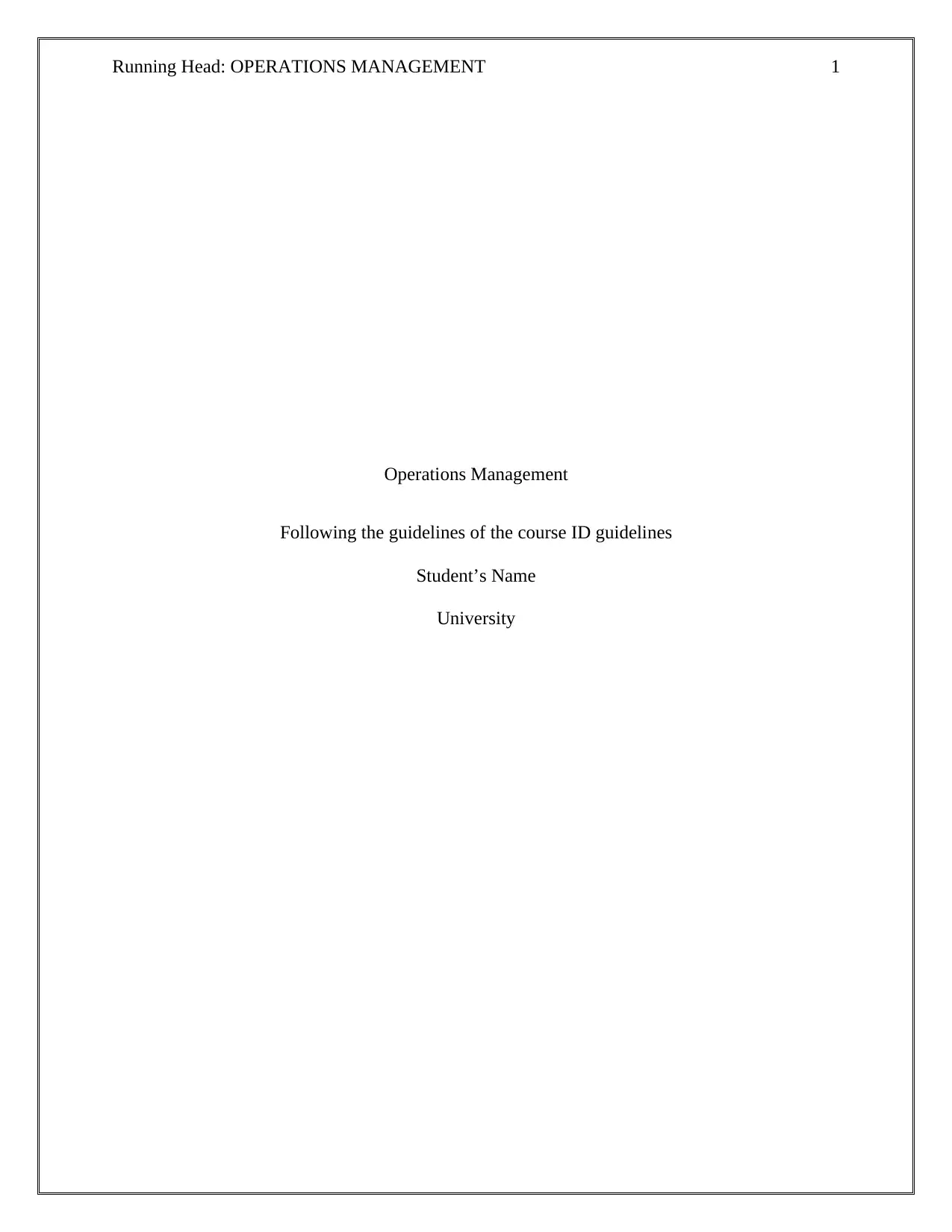
Running Head: OPERATIONS MANAGEMENT 1
Operations Management
Following the guidelines of the course ID guidelines
Student’s Name
University
Operations Management
Following the guidelines of the course ID guidelines
Student’s Name
University
Paraphrase This Document
Need a fresh take? Get an instant paraphrase of this document with our AI Paraphraser
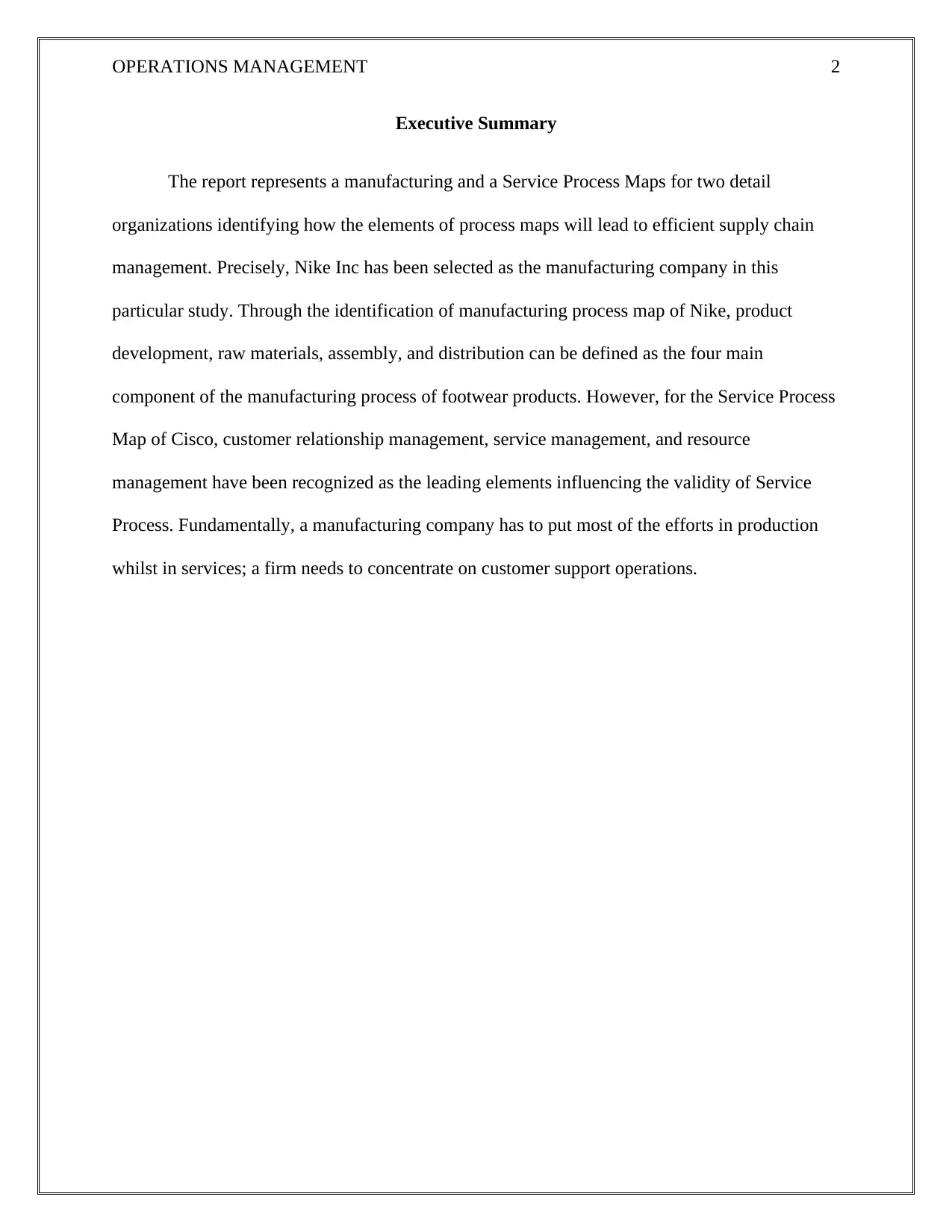
OPERATIONS MANAGEMENT 2
Executive Summary
The report represents a manufacturing and a Service Process Maps for two detail
organizations identifying how the elements of process maps will lead to efficient supply chain
management. Precisely, Nike Inc has been selected as the manufacturing company in this
particular study. Through the identification of manufacturing process map of Nike, product
development, raw materials, assembly, and distribution can be defined as the four main
component of the manufacturing process of footwear products. However, for the Service Process
Map of Cisco, customer relationship management, service management, and resource
management have been recognized as the leading elements influencing the validity of Service
Process. Fundamentally, a manufacturing company has to put most of the efforts in production
whilst in services; a firm needs to concentrate on customer support operations.
Executive Summary
The report represents a manufacturing and a Service Process Maps for two detail
organizations identifying how the elements of process maps will lead to efficient supply chain
management. Precisely, Nike Inc has been selected as the manufacturing company in this
particular study. Through the identification of manufacturing process map of Nike, product
development, raw materials, assembly, and distribution can be defined as the four main
component of the manufacturing process of footwear products. However, for the Service Process
Map of Cisco, customer relationship management, service management, and resource
management have been recognized as the leading elements influencing the validity of Service
Process. Fundamentally, a manufacturing company has to put most of the efforts in production
whilst in services; a firm needs to concentrate on customer support operations.
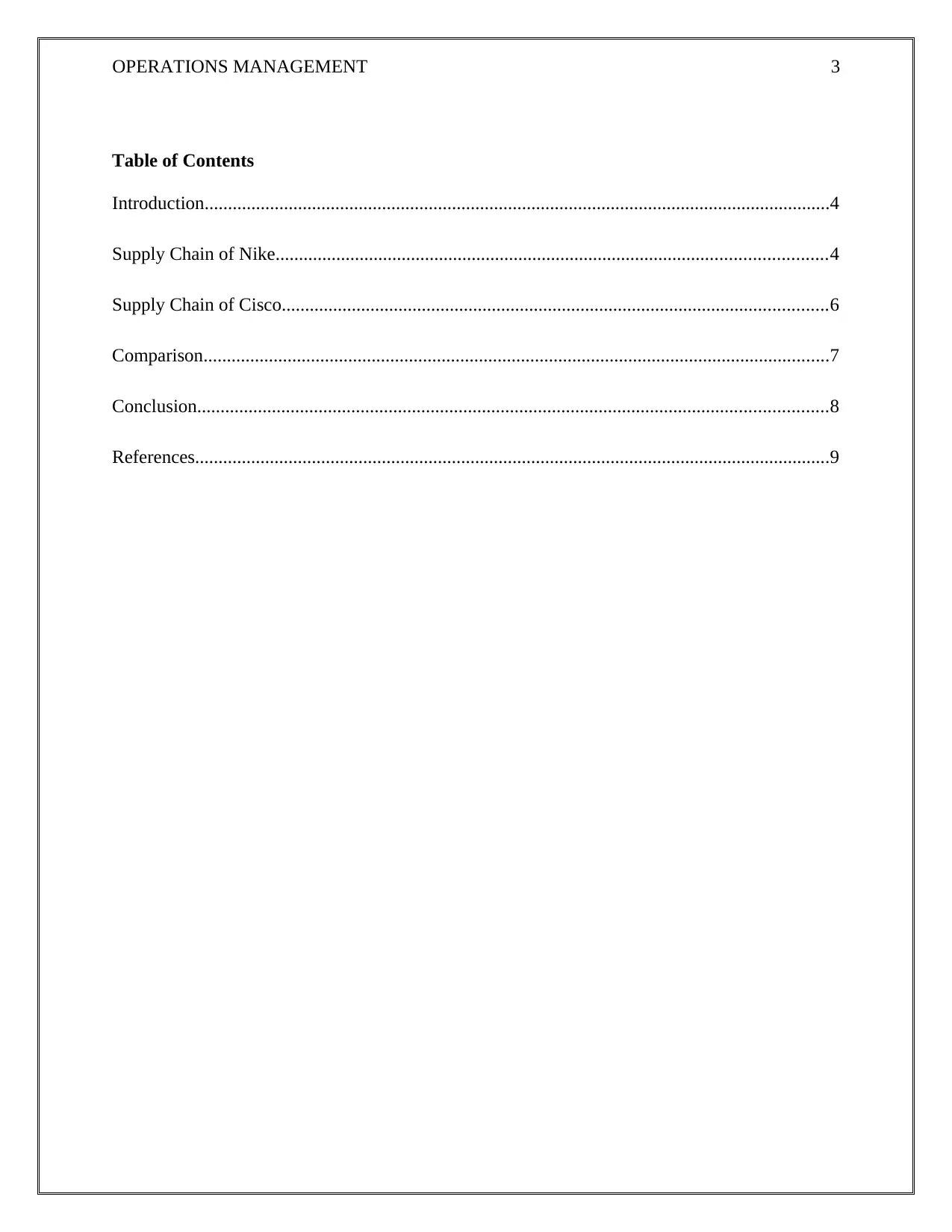
OPERATIONS MANAGEMENT 3
Table of Contents
Introduction......................................................................................................................................4
Supply Chain of Nike......................................................................................................................4
Supply Chain of Cisco.....................................................................................................................6
Comparison......................................................................................................................................7
Conclusion.......................................................................................................................................8
References........................................................................................................................................9
Table of Contents
Introduction......................................................................................................................................4
Supply Chain of Nike......................................................................................................................4
Supply Chain of Cisco.....................................................................................................................6
Comparison......................................................................................................................................7
Conclusion.......................................................................................................................................8
References........................................................................................................................................9
⊘ This is a preview!⊘
Do you want full access?
Subscribe today to unlock all pages.

Trusted by 1+ million students worldwide
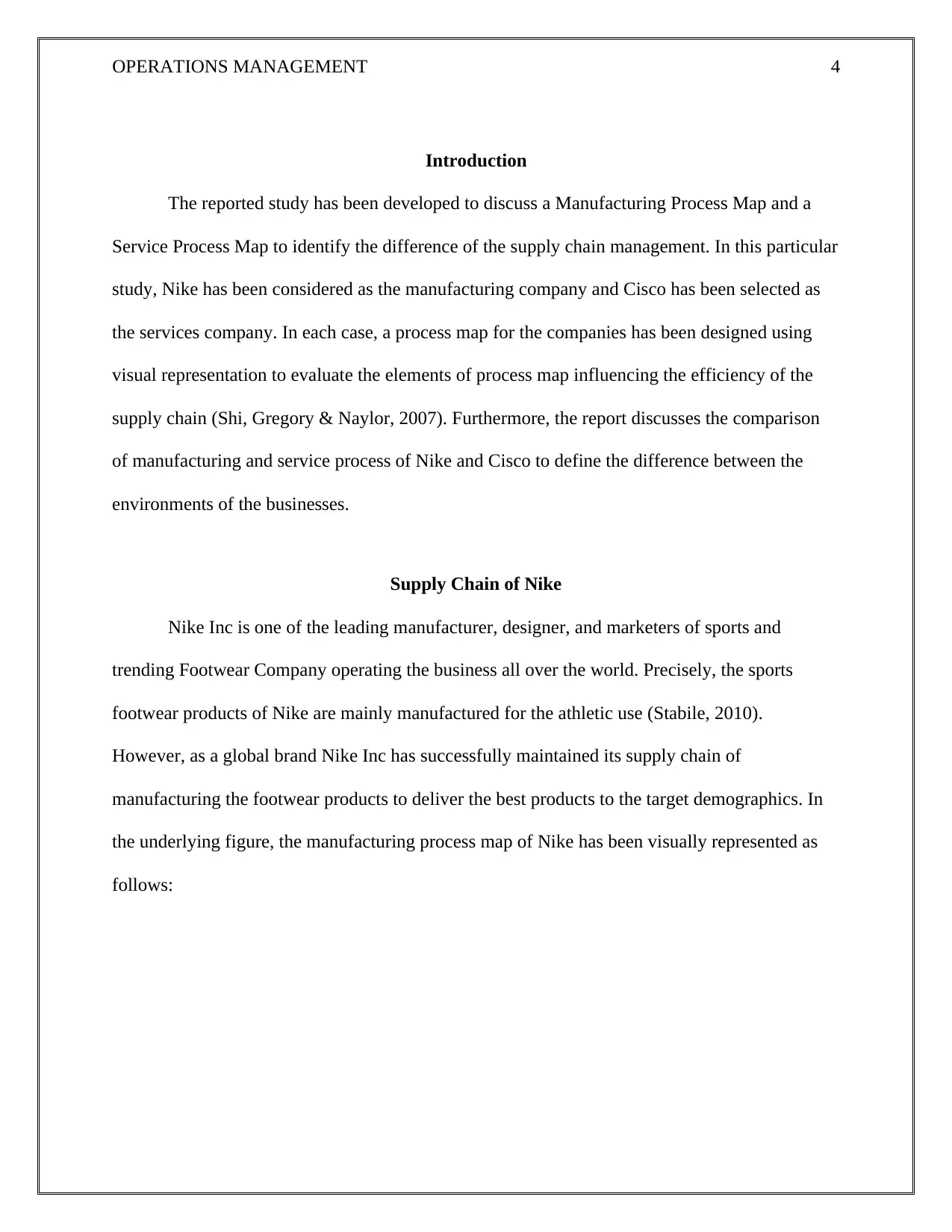
OPERATIONS MANAGEMENT 4
Introduction
The reported study has been developed to discuss a Manufacturing Process Map and a
Service Process Map to identify the difference of the supply chain management. In this particular
study, Nike has been considered as the manufacturing company and Cisco has been selected as
the services company. In each case, a process map for the companies has been designed using
visual representation to evaluate the elements of process map influencing the efficiency of the
supply chain (Shi, Gregory & Naylor, 2007). Furthermore, the report discusses the comparison
of manufacturing and service process of Nike and Cisco to define the difference between the
environments of the businesses.
Supply Chain of Nike
Nike Inc is one of the leading manufacturer, designer, and marketers of sports and
trending Footwear Company operating the business all over the world. Precisely, the sports
footwear products of Nike are mainly manufactured for the athletic use (Stabile, 2010).
However, as a global brand Nike Inc has successfully maintained its supply chain of
manufacturing the footwear products to deliver the best products to the target demographics. In
the underlying figure, the manufacturing process map of Nike has been visually represented as
follows:
Introduction
The reported study has been developed to discuss a Manufacturing Process Map and a
Service Process Map to identify the difference of the supply chain management. In this particular
study, Nike has been considered as the manufacturing company and Cisco has been selected as
the services company. In each case, a process map for the companies has been designed using
visual representation to evaluate the elements of process map influencing the efficiency of the
supply chain (Shi, Gregory & Naylor, 2007). Furthermore, the report discusses the comparison
of manufacturing and service process of Nike and Cisco to define the difference between the
environments of the businesses.
Supply Chain of Nike
Nike Inc is one of the leading manufacturer, designer, and marketers of sports and
trending Footwear Company operating the business all over the world. Precisely, the sports
footwear products of Nike are mainly manufactured for the athletic use (Stabile, 2010).
However, as a global brand Nike Inc has successfully maintained its supply chain of
manufacturing the footwear products to deliver the best products to the target demographics. In
the underlying figure, the manufacturing process map of Nike has been visually represented as
follows:
Paraphrase This Document
Need a fresh take? Get an instant paraphrase of this document with our AI Paraphraser
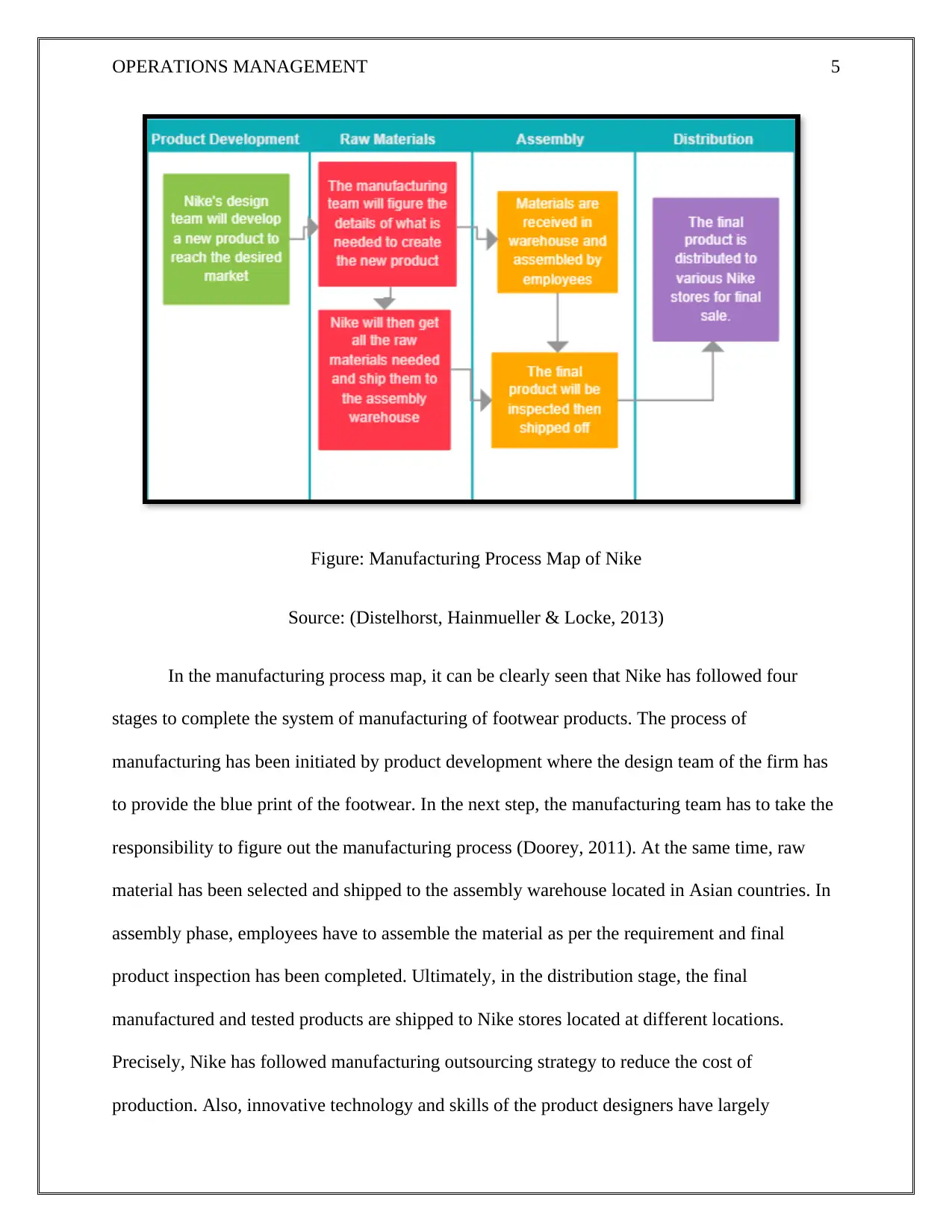
OPERATIONS MANAGEMENT 5
Figure: Manufacturing Process Map of Nike
Source: (Distelhorst, Hainmueller & Locke, 2013)
In the manufacturing process map, it can be clearly seen that Nike has followed four
stages to complete the system of manufacturing of footwear products. The process of
manufacturing has been initiated by product development where the design team of the firm has
to provide the blue print of the footwear. In the next step, the manufacturing team has to take the
responsibility to figure out the manufacturing process (Doorey, 2011). At the same time, raw
material has been selected and shipped to the assembly warehouse located in Asian countries. In
assembly phase, employees have to assemble the material as per the requirement and final
product inspection has been completed. Ultimately, in the distribution stage, the final
manufactured and tested products are shipped to Nike stores located at different locations.
Precisely, Nike has followed manufacturing outsourcing strategy to reduce the cost of
production. Also, innovative technology and skills of the product designers have largely
Figure: Manufacturing Process Map of Nike
Source: (Distelhorst, Hainmueller & Locke, 2013)
In the manufacturing process map, it can be clearly seen that Nike has followed four
stages to complete the system of manufacturing of footwear products. The process of
manufacturing has been initiated by product development where the design team of the firm has
to provide the blue print of the footwear. In the next step, the manufacturing team has to take the
responsibility to figure out the manufacturing process (Doorey, 2011). At the same time, raw
material has been selected and shipped to the assembly warehouse located in Asian countries. In
assembly phase, employees have to assemble the material as per the requirement and final
product inspection has been completed. Ultimately, in the distribution stage, the final
manufactured and tested products are shipped to Nike stores located at different locations.
Precisely, Nike has followed manufacturing outsourcing strategy to reduce the cost of
production. Also, innovative technology and skills of the product designers have largely
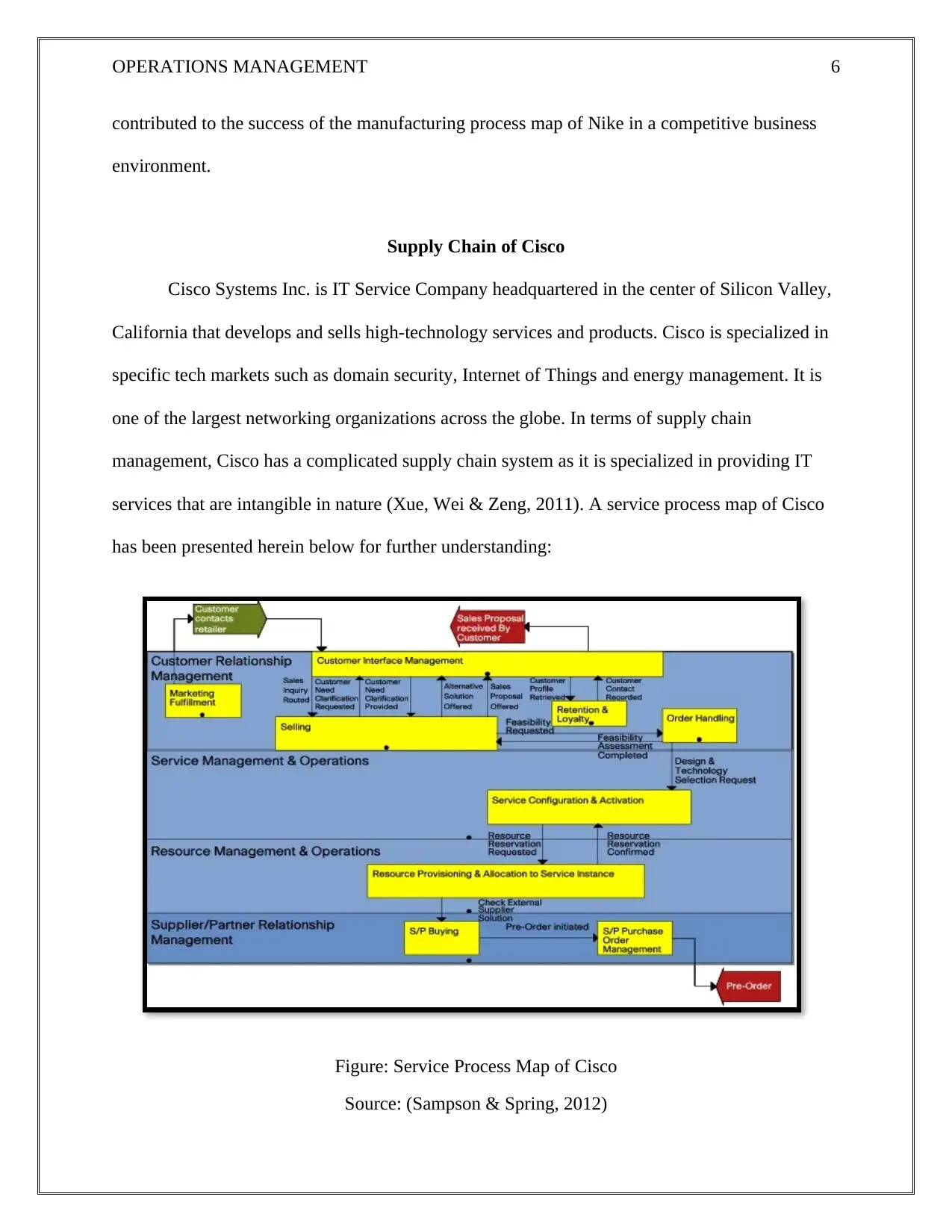
OPERATIONS MANAGEMENT 6
contributed to the success of the manufacturing process map of Nike in a competitive business
environment.
Supply Chain of Cisco
Cisco Systems Inc. is IT Service Company headquartered in the center of Silicon Valley,
California that develops and sells high-technology services and products. Cisco is specialized in
specific tech markets such as domain security, Internet of Things and energy management. It is
one of the largest networking organizations across the globe. In terms of supply chain
management, Cisco has a complicated supply chain system as it is specialized in providing IT
services that are intangible in nature (Xue, Wei & Zeng, 2011). A service process map of Cisco
has been presented herein below for further understanding:
Figure: Service Process Map of Cisco
Source: (Sampson & Spring, 2012)
contributed to the success of the manufacturing process map of Nike in a competitive business
environment.
Supply Chain of Cisco
Cisco Systems Inc. is IT Service Company headquartered in the center of Silicon Valley,
California that develops and sells high-technology services and products. Cisco is specialized in
specific tech markets such as domain security, Internet of Things and energy management. It is
one of the largest networking organizations across the globe. In terms of supply chain
management, Cisco has a complicated supply chain system as it is specialized in providing IT
services that are intangible in nature (Xue, Wei & Zeng, 2011). A service process map of Cisco
has been presented herein below for further understanding:
Figure: Service Process Map of Cisco
Source: (Sampson & Spring, 2012)
⊘ This is a preview!⊘
Do you want full access?
Subscribe today to unlock all pages.

Trusted by 1+ million students worldwide
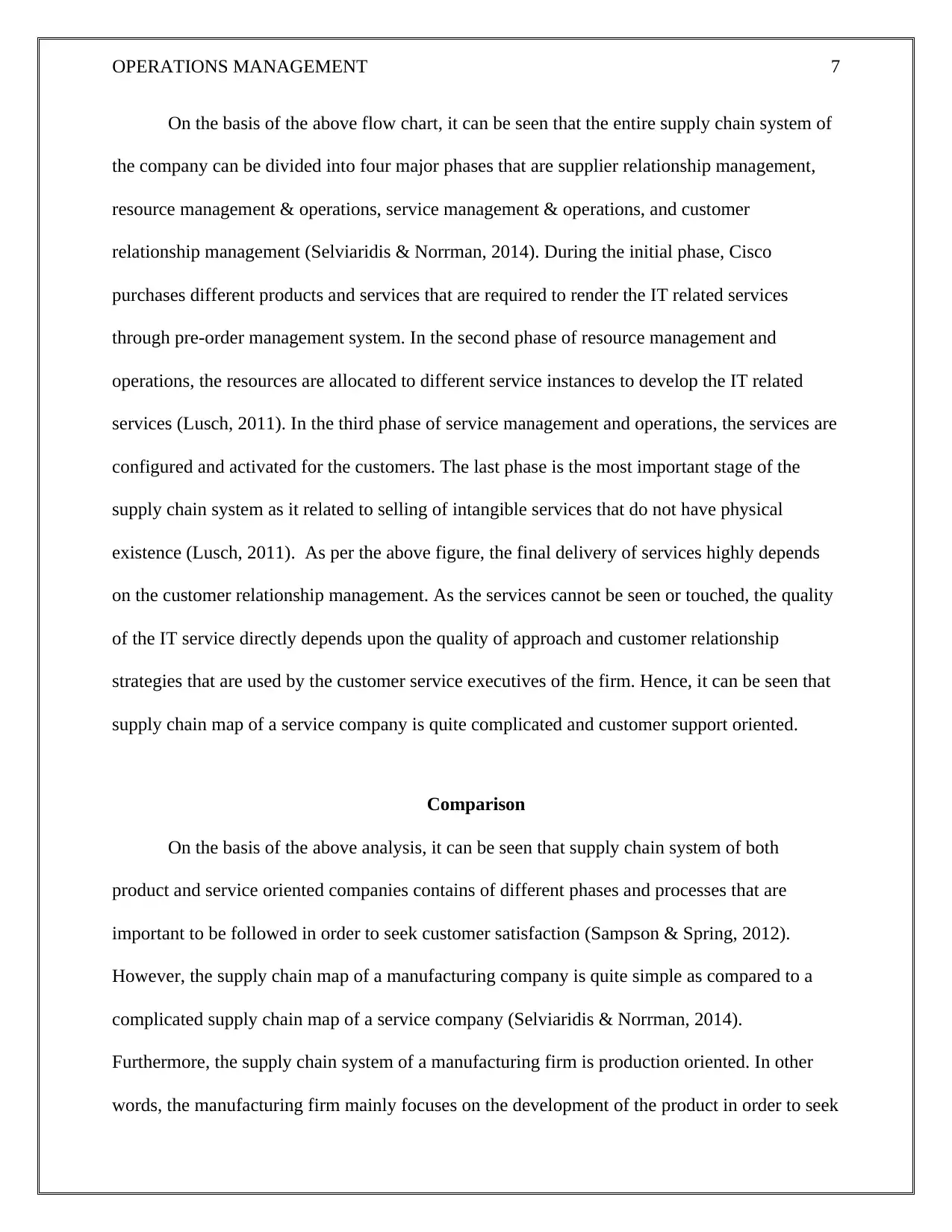
OPERATIONS MANAGEMENT 7
On the basis of the above flow chart, it can be seen that the entire supply chain system of
the company can be divided into four major phases that are supplier relationship management,
resource management & operations, service management & operations, and customer
relationship management (Selviaridis & Norrman, 2014). During the initial phase, Cisco
purchases different products and services that are required to render the IT related services
through pre-order management system. In the second phase of resource management and
operations, the resources are allocated to different service instances to develop the IT related
services (Lusch, 2011). In the third phase of service management and operations, the services are
configured and activated for the customers. The last phase is the most important stage of the
supply chain system as it related to selling of intangible services that do not have physical
existence (Lusch, 2011). As per the above figure, the final delivery of services highly depends
on the customer relationship management. As the services cannot be seen or touched, the quality
of the IT service directly depends upon the quality of approach and customer relationship
strategies that are used by the customer service executives of the firm. Hence, it can be seen that
supply chain map of a service company is quite complicated and customer support oriented.
Comparison
On the basis of the above analysis, it can be seen that supply chain system of both
product and service oriented companies contains of different phases and processes that are
important to be followed in order to seek customer satisfaction (Sampson & Spring, 2012).
However, the supply chain map of a manufacturing company is quite simple as compared to a
complicated supply chain map of a service company (Selviaridis & Norrman, 2014).
Furthermore, the supply chain system of a manufacturing firm is production oriented. In other
words, the manufacturing firm mainly focuses on the development of the product in order to seek
On the basis of the above flow chart, it can be seen that the entire supply chain system of
the company can be divided into four major phases that are supplier relationship management,
resource management & operations, service management & operations, and customer
relationship management (Selviaridis & Norrman, 2014). During the initial phase, Cisco
purchases different products and services that are required to render the IT related services
through pre-order management system. In the second phase of resource management and
operations, the resources are allocated to different service instances to develop the IT related
services (Lusch, 2011). In the third phase of service management and operations, the services are
configured and activated for the customers. The last phase is the most important stage of the
supply chain system as it related to selling of intangible services that do not have physical
existence (Lusch, 2011). As per the above figure, the final delivery of services highly depends
on the customer relationship management. As the services cannot be seen or touched, the quality
of the IT service directly depends upon the quality of approach and customer relationship
strategies that are used by the customer service executives of the firm. Hence, it can be seen that
supply chain map of a service company is quite complicated and customer support oriented.
Comparison
On the basis of the above analysis, it can be seen that supply chain system of both
product and service oriented companies contains of different phases and processes that are
important to be followed in order to seek customer satisfaction (Sampson & Spring, 2012).
However, the supply chain map of a manufacturing company is quite simple as compared to a
complicated supply chain map of a service company (Selviaridis & Norrman, 2014).
Furthermore, the supply chain system of a manufacturing firm is production oriented. In other
words, the manufacturing firm mainly focuses on the development of the product in order to seek
Paraphrase This Document
Need a fresh take? Get an instant paraphrase of this document with our AI Paraphraser
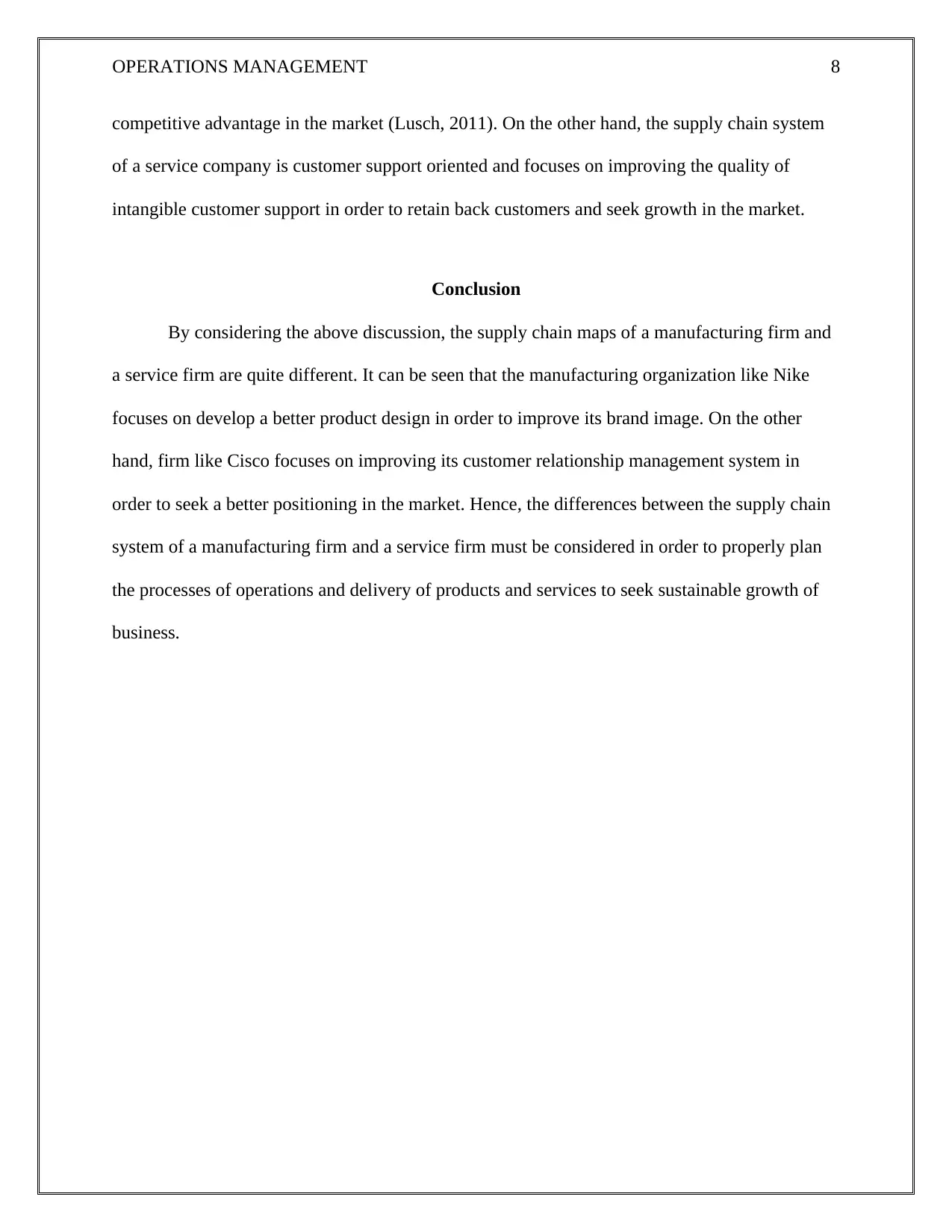
OPERATIONS MANAGEMENT 8
competitive advantage in the market (Lusch, 2011). On the other hand, the supply chain system
of a service company is customer support oriented and focuses on improving the quality of
intangible customer support in order to retain back customers and seek growth in the market.
Conclusion
By considering the above discussion, the supply chain maps of a manufacturing firm and
a service firm are quite different. It can be seen that the manufacturing organization like Nike
focuses on develop a better product design in order to improve its brand image. On the other
hand, firm like Cisco focuses on improving its customer relationship management system in
order to seek a better positioning in the market. Hence, the differences between the supply chain
system of a manufacturing firm and a service firm must be considered in order to properly plan
the processes of operations and delivery of products and services to seek sustainable growth of
business.
competitive advantage in the market (Lusch, 2011). On the other hand, the supply chain system
of a service company is customer support oriented and focuses on improving the quality of
intangible customer support in order to retain back customers and seek growth in the market.
Conclusion
By considering the above discussion, the supply chain maps of a manufacturing firm and
a service firm are quite different. It can be seen that the manufacturing organization like Nike
focuses on develop a better product design in order to improve its brand image. On the other
hand, firm like Cisco focuses on improving its customer relationship management system in
order to seek a better positioning in the market. Hence, the differences between the supply chain
system of a manufacturing firm and a service firm must be considered in order to properly plan
the processes of operations and delivery of products and services to seek sustainable growth of
business.
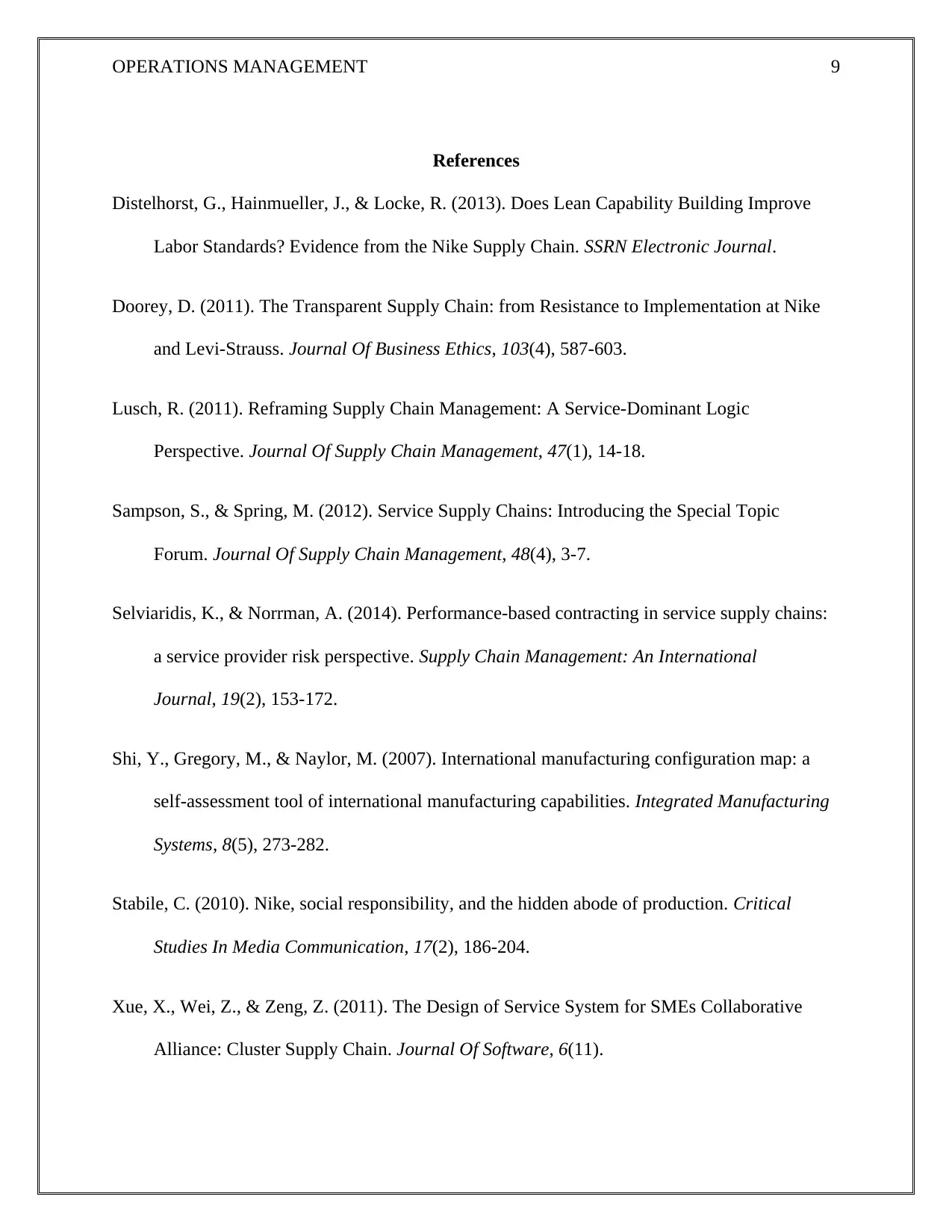
OPERATIONS MANAGEMENT 9
References
Distelhorst, G., Hainmueller, J., & Locke, R. (2013). Does Lean Capability Building Improve
Labor Standards? Evidence from the Nike Supply Chain. SSRN Electronic Journal.
Doorey, D. (2011). The Transparent Supply Chain: from Resistance to Implementation at Nike
and Levi-Strauss. Journal Of Business Ethics, 103(4), 587-603.
Lusch, R. (2011). Reframing Supply Chain Management: A Service-Dominant Logic
Perspective. Journal Of Supply Chain Management, 47(1), 14-18.
Sampson, S., & Spring, M. (2012). Service Supply Chains: Introducing the Special Topic
Forum. Journal Of Supply Chain Management, 48(4), 3-7.
Selviaridis, K., & Norrman, A. (2014). Performance-based contracting in service supply chains:
a service provider risk perspective. Supply Chain Management: An International
Journal, 19(2), 153-172.
Shi, Y., Gregory, M., & Naylor, M. (2007). International manufacturing configuration map: a
self‐assessment tool of international manufacturing capabilities. Integrated Manufacturing
Systems, 8(5), 273-282.
Stabile, C. (2010). Nike, social responsibility, and the hidden abode of production. Critical
Studies In Media Communication, 17(2), 186-204.
Xue, X., Wei, Z., & Zeng, Z. (2011). The Design of Service System for SMEs Collaborative
Alliance: Cluster Supply Chain. Journal Of Software, 6(11).
References
Distelhorst, G., Hainmueller, J., & Locke, R. (2013). Does Lean Capability Building Improve
Labor Standards? Evidence from the Nike Supply Chain. SSRN Electronic Journal.
Doorey, D. (2011). The Transparent Supply Chain: from Resistance to Implementation at Nike
and Levi-Strauss. Journal Of Business Ethics, 103(4), 587-603.
Lusch, R. (2011). Reframing Supply Chain Management: A Service-Dominant Logic
Perspective. Journal Of Supply Chain Management, 47(1), 14-18.
Sampson, S., & Spring, M. (2012). Service Supply Chains: Introducing the Special Topic
Forum. Journal Of Supply Chain Management, 48(4), 3-7.
Selviaridis, K., & Norrman, A. (2014). Performance-based contracting in service supply chains:
a service provider risk perspective. Supply Chain Management: An International
Journal, 19(2), 153-172.
Shi, Y., Gregory, M., & Naylor, M. (2007). International manufacturing configuration map: a
self‐assessment tool of international manufacturing capabilities. Integrated Manufacturing
Systems, 8(5), 273-282.
Stabile, C. (2010). Nike, social responsibility, and the hidden abode of production. Critical
Studies In Media Communication, 17(2), 186-204.
Xue, X., Wei, Z., & Zeng, Z. (2011). The Design of Service System for SMEs Collaborative
Alliance: Cluster Supply Chain. Journal Of Software, 6(11).
⊘ This is a preview!⊘
Do you want full access?
Subscribe today to unlock all pages.

Trusted by 1+ million students worldwide
1 out of 9
Related Documents
Your All-in-One AI-Powered Toolkit for Academic Success.
+13062052269
info@desklib.com
Available 24*7 on WhatsApp / Email
![[object Object]](/_next/static/media/star-bottom.7253800d.svg)
Unlock your academic potential
Copyright © 2020–2025 A2Z Services. All Rights Reserved. Developed and managed by ZUCOL.




